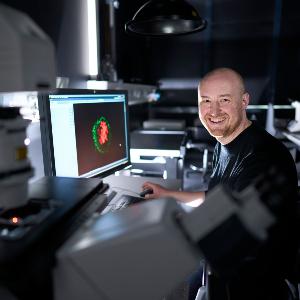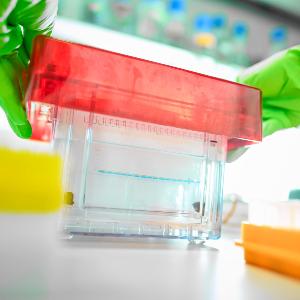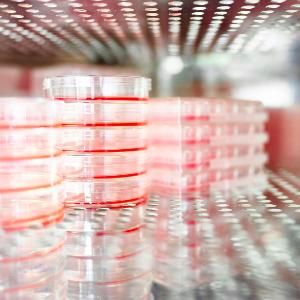Overlooked alarm signal: RNA damage moves into the spotlight
20 Feb 2025
Because RNA is relatively short lived, RNA damage was long dismissed as not that significant. In our interview, biochemist Julian Stingele explains why this view has changed.
20 Feb 2025
Because RNA is relatively short lived, RNA damage was long dismissed as not that significant. In our interview, biochemist Julian Stingele explains why this view has changed.

investigates damage to the nucleic acids DNA and RNA. | © LMU / Jan Greune
Professor at LMU’s Gene Center Munich, Julian Stingele studies the cellular mechanisms that recognize and remove DNA and RNA damage. Using an interdisciplinary approach, he wants to fundamentally understand how cells safeguard their integrity by identifying and degrading damaged nucleic acids. Together with his lab members Jacqueline Cordes and Shubo Zhao, Stingele has written a review article on the subject of RNA damage, which was now published in the renowned journal Cell. In our interview, Stingele talks about recent findings, challenges and future perspectives in RNA damage research.
There has been quite a lot of research into DNA repair, whereas RNA damage has been comparatively neglected. Why is that?
It was long assumed that RNA damage is not that significant. After all, a major difference between RNA and DNA is that the latter is inherited, meaning any damage to DNA can lead to long-term changes in genetic information. RNA molecules, by contrast, are degraded and continually resynthesized. They have a relatively short life and it was, therefore, assumed that RNA lesions are probably not especially significant, because damaged RNA can simply be discarded.
What caused this view to change?
RNA is one of the most important molecules in our cells. Almost every biological function in our cells is mediated by RNA. As such, it is vital that cells safeguard the integrity of their RNA molecules. In the last two to three years, research groups have found evidence that cells mount a complex and specific response to damaged RNA. It turns out, for example, that acute cell death following UV radiation is mediated almost completely by the resulting RNA damage.
Just over a year ago, we discovered a new cellular mechanism that recognizes and degrades damaged RNA molecules. We can thus conclude that there must be selection pressure that ensures such mechanisms develop during evolution. So, there is clearly a need for these mechanisms. Consequently, we want to take a closer look at RNA damage in the future and investigate how cells recognize and degrade it. We’ll be working on really fundamental biological questions here. To support this research, the European Research Council awarded us a Consolidator Grant of two million euro last year.
We’ll be working on really fundamental biological questions hereJulian Stingele

© LMU / Jan Greune
How does RNA damage occur?
Firstly, there is RNA damage caused by environmental influences. This includes the aforementioned UV radiation, but also other types of radiation, such as X-rays and nuclear radiation.
In addition to these external sources, our metabolism constantly produces reactive substances that can damage RNA. That’s perfectly normal, and these reactive molecules generally do not live for very long. But there’s always the chance that one of them will cause damage to RNA. This means we cannot avoid RNA damage, even if we never go out in the sun.
In your review article, you mention two key roles in the recognition of RNA damage. What are they?
One is the RNA damage response, which we think is important for ensuring the immediate survival of the cell. Restoring the function of the damaged RNA is not the priority here. We hypothesize, rather, that recognizing and degrading the damage is more important. This works astonishingly well. When we induce RNA damage in cells, we see that cells respond very efficiently within minutes.
Another aspect is the following: When a cell incurs RNA damage, then it probably always suffers from DNA damage at the same time. It is our hypothesis that recognizing RNA damage serves as an alarm signal for the cell that there might be a problem with DNA as well. The cell can then trigger its own death and prevent itself from, say, transforming into a tumor cell.
Conceptually, the evidence is building up that cells do not recognize the damage directly but rather detect its effects indirectly. The mechanism we found is triggered, for example, when the damage blocks the translation of mRNA by the ribosome. When a ribosome gets stuck on an RNA lesion, a trailing ribosome will eventually bump into it. These collisions set off the cellular RNA damage response. As the exact nature of the damage is largely irrelevant to the induction of ribosome collisions, this is a very efficient mechanism for recognizing various kinds of RNA damage.
We cannot avoid RNA damage, even if we never go out in the sunJulian Stingele
What are the greatest challenges in researching RNA damage?
It’s a major challenge that most sources of RNA damage also cause damage to DNA. As such, when we examine cells, it’s quite difficult to distinguish whether the effect was due to the RNA damage or to the DNA damage which occurred at the same time.
As a solution to this problem, we’re trying to develop systems where we can specifically damage RNA without simultaneously causing damage to DNA. One trick we use is to “feed” cells with a certain modified building block. This building block is incorporated only into RNA, and not into DNA, and can then, after its incorporation into RNA, be targeted for damage through low-energy radiation. In this way, we can specifically cause RNA damage and analyze what effects can be attributed to this damage.
Are there indications that RNA damage may be connected with certain diseases?
We’re still at the beginning here, but there are various indications. A diet rich in fat and sugar, for example, often leads to the formation of so-called reactive oxygen species. Research using a mouse model has suggested that the inflammation associated with such a diet is largely caused by RNA damage.
There is more direct evidence in chemotherapy, which is an area my research group focuses on. The accepted mechanism for many chemotherapeutics is that they damage the DNA in the tumor cells, ultimately causing these cells to die.
But many of these chemotherapeutics also damage RNA. There has been little research before now into the degree to which RNA damage contributes to the success of the therapy or its side effects. We’re investigating the chemotherapeutic azacitidine, which is used primarily to treat a particular type of leukemia. And what we’re seeing, at least in cell cultures, is that the acute toxicity of this chemotherapeutic is mediated almost completely via RNA damage.
Could this have medical relevance?
For us, it was interesting that a chemotherapeutic which has been used for years probably works in an entirely different way than was thought. The medication does not work in all patients, and we still don’t know why. It would be important to understand how exactly it works, allowing us to predict which patients will respond well to the treatment and which will not.
Through genetic screening, we tested all 20,000 human genes and identified a gene that regulates the RNA damage response to this chemotherapeutic. When this gene is removed, cells become very sensitive to chemotherapy. By contrast, you can remove a huge variety of genes for DNA repair without seeing this effect. We couldn’t have imagined that we would see such a dramatic difference.
Naturally, we hope we’ll be able to pharmacologically modulate this RNA damage response one day, so that we can make tumor cells more sensitive to RNA damage, for example, and thus improve therapies.
It was interesting that a chemotherapeutic which has been used for years probably works in an entirely different way than was thoughtJulian Stingele

© LMU / Jan Greune
Which questions do you think should be studied in the future?
One avenue should be to investigate more disease-relevant questions – for example, exploring to what degree RNA damage is caused by chemotherapies and how this affects the success of treatment.
Another blind spot we want to address is the effects of damage to different types of RNA. Almost all research is currently focused on damage to mRNAs – which are the blueprints for protein production. But mRNAs make up just a small proportion of the RNA in our cells. The majority of cellular RNAs carry out other functions. We know little to nothing about how damage is recognized in these RNA molecules and what the consequences are. This is another area we’re strongly focused on.
The environment at LMU offers ideal conditions for this work. We can collaborate with leading experts in the fields of ribosome and RNA biology and, thanks to cooperation with partners at LMU University Hospital, we do not have to go far to work with doctors who use the chemotherapies we’re studying.
What’s your personal motivation for working in this still young research field?
Suddenly a whole new perspective has opened up, which is very stimulating and interesting. It’s incredibly rewarding to have such a large field in front of you, to which you can make a real contribution. There are research questions galore – the problem is deciding which to tackle first.